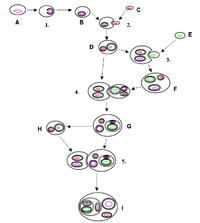
Spacer Cation Tuning Enables Vertically Oriented and Graded Quasi‐2D Perovskites for Efficient Solar Cells
Sign Up to like & getrecommendations! Published in 2020 at "Advanced Functional Materials"
DOI: 10.1002/adfm.202008404
Abstract: Halide substitution in phenethylammonium spacer cations (X‐PEA+, X = F, Cl, Br) is a facile strategy to improve the performance of PEA based perovskite solar cells (PSCs). However, the power conversion efficiency (PCE) of X‐PEA… read more here.
Keywords: spacer cation; pea; pea pea; pea based ... See more keywords

Fitness comparison of Plutella xylostella on original and marginal hosts using age‐stage, two‐sex life tables
Sign Up to like & getrecommendations! Published in 2021 at "Ecology and Evolution"
DOI: 10.1002/ece3.7804
Abstract: Abstract The diamondback moth, Plutella xylostella, is an important agricultural pest that severely damages cruciferous vegetables. Although previously considered a threat only to Brassica species, P. xylostella has been observed to feed on noncruciferous vegetables.… read more here.
Keywords: xylostella; pea; life; rate ... See more keywords

The effect of the inclusion of pea in lamb fattening concentrate on in vitro and in situ rumen fermentation.
Sign Up to like & getrecommendations! Published in 2020 at "Journal of the science of food and agriculture"
DOI: 10.1002/jsfa.10938
Abstract: BACKGROUND The objective of this study was to evaluate the effect of the proportion of pea (0%, 10%, 20% and 30%), as a partial replacement of soybean meal (SBM), in the fattening concentrate on ruminal… read more here.
Keywords: inclusion; production; matter; pea ... See more keywords

Biofortification of pea (Pisum sativum L.): A Review.
Sign Up to like & getrecommendations! Published in 2021 at "Journal of the science of food and agriculture"
DOI: 10.1002/jsfa.11059
Abstract: Biofortification refers to an approach to increase micronutrient concentrations in the edible parts of plants with increased bioavailability to the human population. Conventional, agronomic and transgenic breeding methods can be used to develop these biofortified… read more here.
Keywords: pea; pea pisum; pisum sativum; sativum review ... See more keywords

Impact of residual pulmonary hypertension on long‐term outcomes after pulmonary endarterectomy in the modern era
Sign Up to like & getrecommendations! Published in 2023 at "Pulmonary Circulation"
DOI: 10.1002/pul2.12215
Abstract: Abstract Residual pulmonary hypertension (PH) negatively impacts long‐term results following pulmonary endarterectomy (PEA) for chronic thromboembolic pulmonary hypertension (CTEPH). We sought to reveal whether modern PH therapy with PH‐targeted medicine and balloon pulmonary angioplasty (BPA)… read more here.
Keywords: long term; pulmonary hypertension; medicine; pea ... See more keywords

Grass pea (Lathyrus sativus) flour: microstructure, physico-chemical properties and in vitro digestion
Sign Up to like & getrecommendations! Published in 2018 at "European Food Research and Technology"
DOI: 10.1007/s00217-018-3152-y
Abstract: Flour from grass pea, a legume that is adapted to arid conditions containing high levels of proteins, was characterized according to microstructure, some functional properties and digestibility. Microstructural results showed that grass pea starch granules… read more here.
Keywords: vitro digestion; pea; grass pea; starch ... See more keywords

Genetic manipulation of pea (Pisum sativum L.) with Arabidopsisˈs heat shock factor HsfA1d improves ROS scavenging system to confront thermal stress
Sign Up to like & getrecommendations! Published in 2020 at "Genetic Resources and Crop Evolution"
DOI: 10.1007/s10722-020-00966-9
Abstract: Arabidopsisˈs HsfA1d was found to confer resistance to pea plant against heat stress by enhancing the activity of antioxidant enzymes and decreasing hydrogen per oxide compared to wild type plants. Pea is one of the… read more here.
Keywords: thermal stress; hsfa1d; pea; heat stress ... See more keywords

A diversity of resistance sources to Fusarium oxysporum f. sp. pisi found within grass pea germplasm
Sign Up to like & getrecommendations! Published in 2021 at "Plant and Soil"
DOI: 10.1007/s11104-021-04895-z
Abstract: Grass pea is a legume species with recognized resistance to several diseases and thus important for the improvement of related major legume crops. It is infected by the soil-borne fungus Fusarium oxysporum f. sp. pisi… read more here.
Keywords: resistance; pea; fusarium oxysporum; grass pea ... See more keywords

Pea Protein Nanoemulsion and Nanocomplex as Carriers for Protection of Cholecalciferol (Vitamin D3)
Sign Up to like & getrecommendations! Published in 2019 at "Food and Bioprocess Technology"
DOI: 10.1007/s11947-019-02276-0
Abstract: Pea protein is one of the few hypoallergenic vegetable proteins without genetic modification issues. Pea protein isolate (PPI) is a natural emulsifier with high nutritional value. Nevertheless, PPI’s applications in foods are limited by its… read more here.
Keywords: protection; pea; pea protein; nanoemulsion ... See more keywords

On the Efficacy of Cardio-Pulmonary Resuscitation and Epinephrine Following Cyanide- and H2S Intoxication-Induced Cardiac Asystole
Sign Up to like & getrecommendations! Published in 2018 at "Cardiovascular Toxicology"
DOI: 10.1007/s12012-018-9454-2
Abstract: This study was aimed at determining the efficacy of epinephrine, followed by chest compressions, in producing a return of spontaneous circulation (ROSC) during cyanide (CN)- or hydrogen sulfide (H2S)-induced toxic cardiac pulseless electrical activity (PEA)… read more here.
Keywords: epinephrine; intoxication; pea; efficacy ... See more keywords

Trace Metals Accumulated in Pea Plant (Pisum sativum L.) as a Result of Irrigation with Wastewater
Sign Up to like & getrecommendations! Published in 2020 at "Journal of Soil Science and Plant Nutrition"
DOI: 10.1007/s42729-020-00341-8
Abstract: Trace metals (TMs) that accumulated in different crops irrigated with untreated wastewater are public hazard problem. The present work aimed to evaluate the impact of utilizing untreated agricultural water in the irrigation system of the… read more here.
Keywords: wastewater; soil; pea; seed ... See more keywords